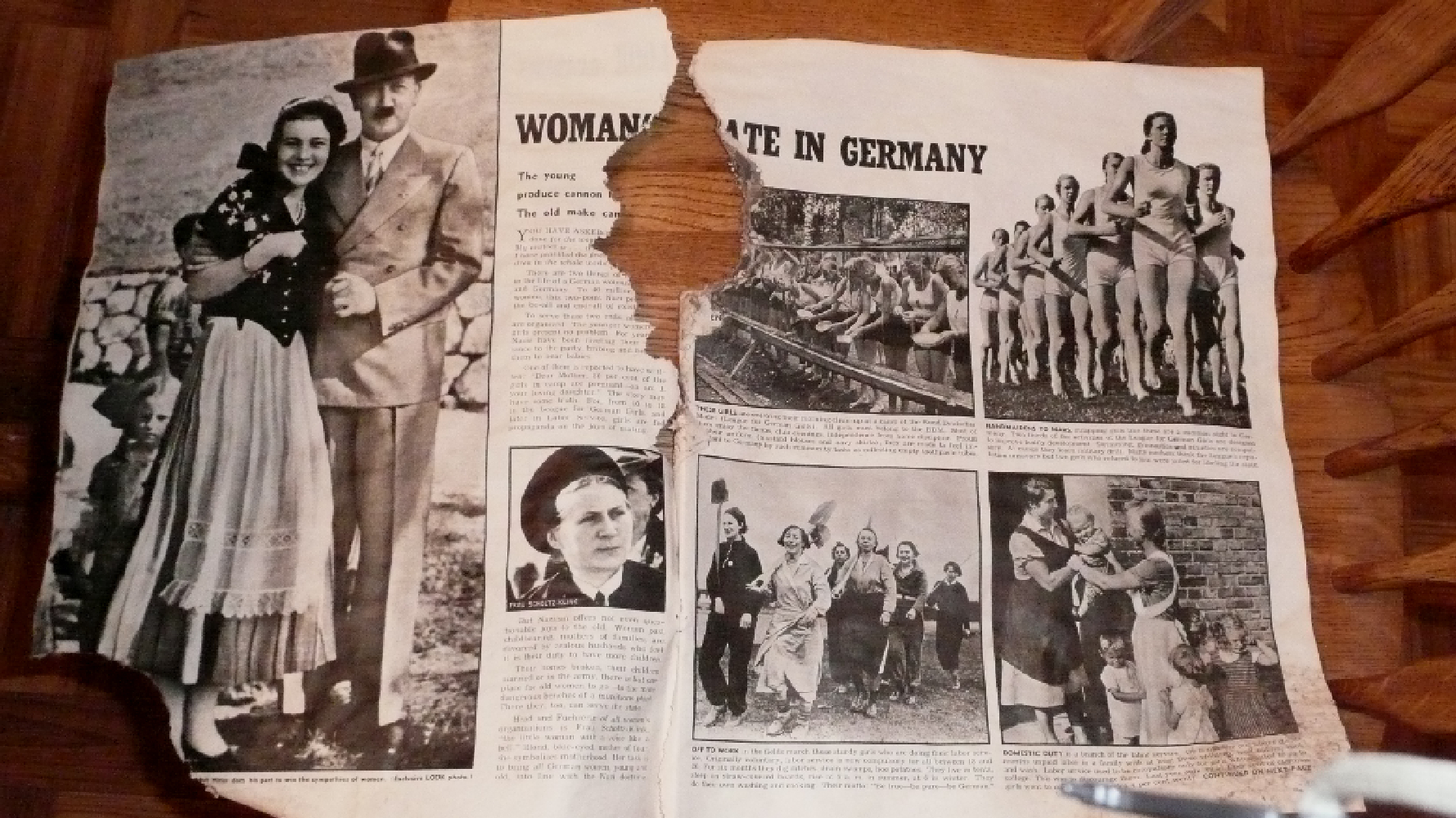|
Moderated by NW Okie! |
Volume 9 , Issue 382007Weekly eZine: (366 subscribers)Subscribe | Unsubscribe Using Desktop... |
Treasures Found On 12th Street, Alva, OK

Sometimes unexpected treasures can be found while tearing down old houses. That has happened to us as we continue our demolition journey of our 12th street houses these last couple of weeks.
Besides a January, 1927 letter postmarked from Lyons, Kansas, we found a partially rat-eaten LOOK magazine without its front cover) that dated back to sometime around 1940, maybe the late 1939.
In that LOOK magazine of 1940, there was an article in there about Germany, women's fate in Germany (young & old), with the headlines that read: "Women's Fate In Germany." There was a picture of Adolf Hitler posing with a young girl; women marching; cleaning up at a camp trough; being trained as wives, mothers and baby makers.
The article also mentioned that from 10 to 18 in the League for German Girls, and later in Labor Service, girls were fed propaganda on the joys of mating. When a woman was past the childbearing age, they were divorced by zealous husbands who felt it was their duty to have more children. The older women were sent to the more dangerous benches of a munitions plant so they could serve their country.
Back then the head Fuehrerin of all women's organizations was Frau Scholtz-Klink, "The little woman with a voice like a bell." She was blond, blue-eyed, mother of four and symbolized motherhood. her task was to bring all German women, young and old, into line with the Nazi doctrine.
There was a picture in the LOOK magazine showing a line of girls at their morning clean-up at a camp of the Bund Deutscher Madel (League for German Girls). All girls must belong to the "BDM."
It was also reported that most of the young women enjoyed the camps, club evenings, independence from home discipline. They were proud of their uniform (mustard blouses and navy skirts) -- they were made to feel important to Germany by such community tasks as collecting empty toothpaste tubes.
It goes on to say that two thirds of the activities of the League for German Girls were designed to improve bodily development. Swimming, gymnastics and athletics were compulsory. At camps they learned military drill. Many mothers thought the League's reputation unsavory but two girls who refused to join were jailed for libeling the state.
On that same page there were a group of girls marching off to work in the fields, carrying shovels. They were reported as doing their labor service. Originally voluntary, labor service was back in the late 1940 compulsory for all between 18 and 20. For six months they dug ditches, drained swamps, hoed potatoes. They lived in tents, slept on straw-covered boards, arose at 5 a.m. in summer, at 6 in winter. They did their own washing and cooking. Their motto: "Be true -- be pure -- be German."
The women's domestic duty was another branch of the labor service. Girls did six months unpaid labor in a family with at least three children; tend babies, cook and wash. Labor service used to be compulsory only for girls who wanted to go to college. This was to discourage them. In 1939 only .69 of 1 percent of German girls went to college (in america 4 percent went).
As we turn the page of this old LOOK magazine the German article continues on page 12 with the headlines: Marriage and Babies Are A Mass-production Industry In Germany." It starts out with, "Marriage in Germany is not a religious ceremony, nor is it a personal matter. It is assessed only on its state value, and a marriage which produces healthy Aryan children must be maintained even though the partners don't like it."
This fact -- along with encouragement of illegitimacy and the theory that children belonged to the state -- makes it clear that, however much they exalt motherhood or glorify family life, the Nazis were interested chiefly in mass production of babies. Back then, Germany was a masculine country. AND... if you were blond, Aryan boy and girl, you were physically perfect Germans according to Nazi race theorists. The Nazis made a fetish of blondness. To improve the race they sterilized the unfit, and had set up eugenic clinics where couples intending marriage must pass health tests.
There were 150 "mother schools: where some unmarried women learned to sew; studied hygiene, cooking, care of babies, paying two to five marks for each course. All women were encouraged to attend but the schools were compulsory only for intended wives of SS men.
Tough divorces were increasing, marriage loans and bachelor taxes kept the Nazi marriage and birth rates high. Suppression of birth control also played a part. Even "unwanted" babies were wanted by the state. The war had given marriage a recent further fillip. Registry offices were crowded, and soldiers on duty in the Siegfried line could be married by proxy.
Back in 1940 the LOOK magazine stated that all women must register for work to release men for war duties or jobs in heavy industry. They worked on farms, in munitions factories, as conductors on trains and trolleys. These women conscripts worked 10 hours a day, six days a week, were exempt only in the last months of pregnancy or while nursing infants.
Here is hoping that women have come along way since then! AND... American women, aren't you glad you didn't have to suffer the fate of the German women in the 1940's?
| View or Add Comments (0 Comments)
| Receive
updates ( subscribers) |
Unsubscribe
| © . Linda Mcgill Wagner - began © 1999 Contact Me | |
